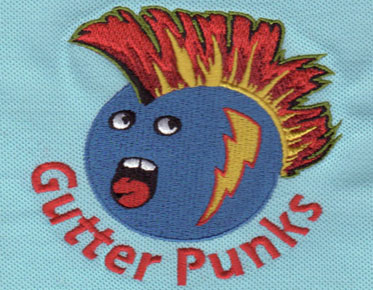Knowledge from Eagle digitizing: Choosing the Right Embroidery Threads for Your Projects
This paper is not intended to cover the whole science of how to create the lines and the details of every potentially available embroidery line. On the contrary, EagleDigitizing give you a brief overview of how to choose the most common embroidery thread.
The following are the two most basic criteria for selecting threads for your design:
1. Always use high-quality thread designed for embroidery; This includes spool threads.
2. Check the color reference table of the design (this is usually a PDF file, which is included in the download file or design set CD) to see if there are any special threads and what type of thread is used.
Use high quality thread
Trying to reduce the cost of embroidery by purchasing cheap thread is not an economic decision; Price is not the only cost involved in threads. Cheap thread is easier to break and tear. For worn threads, the embroidery will look like "sandpaper" only after the sewing process. Your sewing time will increase, your frustration will increase, and your sewing quality will decline. Is it worth saving a little money? Embroidery extends the service life of clothing, using high-quality ingredients! A good, high-quality embroidery thread not only makes the work of an embroiderer possible, but also makes it more eye-catching, and to be honest, it is worth more money.
What is a good thread?
First of all, choose one that is specially made for embroidery, not only for needles, but also for spools. Do not attempt to replace the axis of the embroidery thread with the embroidery thread. I prefer spinning polyester pre winding spool. If the machine I am using requires machine specific spools, I can simply wind one of the spools from the pre winding. Polyester spinning pre winding spool
High quality lines are smooth and feed evenly. Poor quality lines have thick and thin areas, which limit smooth flow, resulting in excessive fluff and peeling. Keep the light colored yarn and dark colored fabric, and fix the dark colored yarn on the light colored fabric to check the quality. Look for color fastness, which is the ability to maintain color during normal use, including... under appropriate washing conditions. Color fastness does not mean fast bleaching, or even resistance to bleaching. Also check the ability to retain color when exposed to sunlight for long periods of time.
Polyester or rayon
Until the early 1990s, rayon was the overwhelming choice for embroidery. It has strength, luster and softness, and can run smoothly in the machine and produce beautiful and consistent stitches. Polyester is the most popular product because of its strength, chlorine bleach resistance, abrasion resistance and other environmental and chemical effects. It is also more economical than rayon. However, if you are not careful to manage the machine tension and proper hoop technology, the strength of polyester may be its weakness. At higher tensions, the polyester fibers stretch and the rayon breaks - which means you may not be aware of tension issues. After sewing, the thread will relax back to the normal state, causing the fabric to wrinkle.
What color and type?
Hemingway Thread Color Chart When selecting threads for your design, first check the color reference table of the design to determine which colors are used and whether any special threads are used. A reputable digitizer will use any required professional threads to test its design, as adjustments must be made during digitization. If you choose different types of threads, you may get unexpected results. For example, if metal thread is used instead of embroidery thread, the stitch length may be too short and/or the area density may be too high to sew smoothly. Translation: Many broken lines!
Thread weight or size
When measuring the thread, the larger the number, the thinner or thinner the thread. Therefore, 60 wt is finer than 40 wt and 40 wt is finer than 30 wt.
Generally, most designs are digitalized for 40wt rayon or polyester wire. Yes, technically, there is such a slight difference in the actual thickness of these lines, but for our purposes, it is not worth considering. Note that the 2-color twist is typically 35 wt, which gives a thicker feel, but in most cases can replace 40 wt.
What if I use a brand different from the designed color reference chart?
I often find myself in this situation. For monochrome (monochrome) designs, this is not a problem at all. Most of the time, you choose the color according to the fabric or your personal preference. I am also confident in my ability to select colors that can blend well even in most multicolor designs.
Consider the case where you are embroidering a design with multiple colors, which have a tight mix. In this case, if your brand does not provide a comparable color range, replacing the brand may cause problems. I encountered this problem. I used a brand line to digitize a series of dogs. This brand was not widely used by family embroiderers. I could not find the brown, beige and caramel series I needed among the popular brands at that time. So if you need different brand colors, please buy! If there are comparable colors in your collection that you are satisfied with, be sure to use them. There is no line color police (the company is closed). If you don't use the same color as the original designer, they will harass you.
Thread care
If exposed to sunlight, light, heat, moisture, dust, dirt and dryness, the wire will quickly age. Old thread is easier to break and tear. The thread fiber will be bruised due to falling or collision, and the oil on the hand will decompose some fibers. I particularly like the new thread of Hemingway. Their plastic covers protect the threads from impact and dirt, eliminate tangles, and keep the threads running smoothly on the machine. In addition, they have a beautiful color range. Hemingway thread spool and cover system
Needle
If Bessel embroidery needle does not talk about needle, any discussion about thread is incomplete. The needle has an extremely important task, that is, to carry the thread through the fabric, remove the loop from the spool to form a stitch, and then pull the thread out. The correct needle is the smallest needle, which can be repeated without damaging the fabric or thread and causing excessive needle deflection.
For 40wt thread, I prefer 75/11 needle,
unless the fabric is "tough", and then I will increase the size to a
slightly heavier 80/12 needle. Synthetic fabrics wear the needles more quickly
than natural fibers, so be sure to replace the needles as needed. Like cheap
thread, cheap needle or using needle too long is a false economy.



